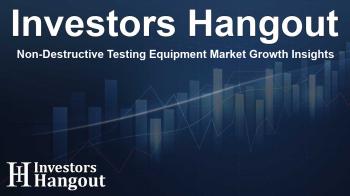Non-Destructive Testing Equipment Market Growth Insights

Expanding Horizons of Non-Destructive Testing Equipment
The global non-destructive testing equipment market is on a trajectory to reach an impressive valuation, with expectations for the value to climb to US$ 5,342.1 million in the coming years. This growth is primarily fueled by ongoing advancements in technology and the critical requirements for rigorous inspection processes across various industries.
Significance of NDT in Modern Industries
Non-destructive testing (NDT) is becoming increasingly essential due to the growing complexity of machinery in multiple sectors. Industries such as oil and gas, aerospace, and defense rely heavily on NDT techniques to ensure safety and operational integrity. Among various methods, ultrasonic testing stands out for its unmatched precision and adaptability.
Technological Innovation Driving NDT Adoption
As industries advance toward digitalization, there is a significant shift toward integrating technological solutions into traditional inspection methods. Portable NDT equipment is emerging as a game changer, offering flexibility and ease of use, particularly in areas where access may be limited. This technology allows for inspections to be carried out quickly and accurately, ensuring the reliability of results while maintaining safety standards.
IoT Integration Revolutionizing NDT Practices
The integration of the Internet of Things (IoT) within NDT equipment is transforming conventional testing methodologies. These smart devices enable real-time data collection and analysis, providing valuable insights that enhance testing accuracy. With capabilities for predictive maintenance, industries can now monitor the health of their equipment continuously, allowing for proactive measures to minimize potential failures.
Market Trends and Growth Factors
The potential for significant growth in the NDT market correlates with the rising demand for innovative testing solutions in automotive, aerospace, energy, and construction sectors. As society evolves, so do the challenges associated with infrastructure safety and longevity. With infrastructure aging across the globe, NDT is becoming a vital component to ensure that both existing and new structures adhere to safety regulations.
Infrastructure Safety Demands NDT Solutions
Amidst the backdrop of escalating urbanization, the importance of NDT cannot be overstated. With millions of structures requiring regular inspection to maintain their integrity, including aging bridges and roads, the application of NDT techniques is both a necessity and a solution. It is projected that the requirement for non-destructive testing will surge as global construction efforts are set to rise substantially in the coming years.
Volumetric Examination: A Leader in NDT Techniques
Recent data shows that volumetric examination has secured a leading position within the market, capturing more than 43% of the total revenue share. This technique is favored for its capacity to thoroughly assess the internal make-up of materials, ensuring that any subsurface issues are detected and addressed. The consistent demand for thorough internal inspections in various sectors underscores its significance.
Variety of Testing Methods Available
The NDT landscape includes a variety of testing methods, each crucial for specific applications. Techniques such as liquid penetrant testing, radiographic testing, and eddy current testing are also widely used, tailored to the unique requirements of different materials and industries. Surface examination, while less dominant than volumetric methods, caters to quality and integrity needs in sectors like automotive and maritime.
Prominent Players in the NDT Market
In a competitive landscape, several key players are shaping the NDT market. Companies like Ashtead Technology, Carestream Health, and General Electric are leading the charge with innovative solutions designed to meet the diverse needs of various sectors. This competition spurs continual advancements and improvements in non-destructive testing technologies.
Frequently Asked Questions
What is the projected value of the global NDT equipment market?
The market is expected to reach US$ 5,342.1 million by 2032.
Why is NDT critical for industries?
NDT is essential for ensuring the safety and integrity of complex machinery and structures across various sectors.
How is technology impacting the NDT market?
Technological advancements, particularly the integration of IoT and portable equipment, are enhancing inspection accuracy and efficiency.
Which industries are the primary users of NDT equipment?
Industries such as oil and gas, aerospace, and construction are the primary users of non-destructive testing equipment.
What role does volumetric examination play in NDT?
Volumetric examination is leading the market due to its ability to thoroughly assess the internal structure of materials and identify potential flaws.
About The Author
Contact Riley Hayes privately here. Or send an email with ATTN: Riley Hayes as the subject to contact@investorshangout.com.
About Investors Hangout
Investors Hangout is a leading online stock forum for financial discussion and learning, offering a wide range of free tools and resources. It draws in traders of all levels, who exchange market knowledge, investigate trading tactics, and keep an eye on industry developments in real time. Featuring financial articles, stock message boards, quotes, charts, company profiles, and live news updates. Through cooperative learning and a wealth of informational resources, it helps users from novices creating their first portfolios to experts honing their techniques. Join Investors Hangout today: https://investorshangout.com/
The content of this article is based on factual, publicly available information and does not represent legal, financial, or investment advice. Investors Hangout does not offer financial advice, and the author is not a licensed financial advisor. Consult a qualified advisor before making any financial or investment decisions based on this article. This article should not be considered advice to purchase, sell, or hold any securities or other investments. If any of the material provided here is inaccurate, please contact us for corrections.

